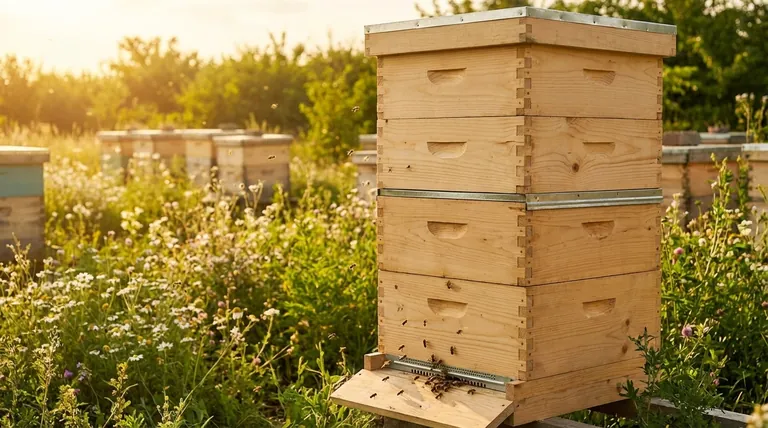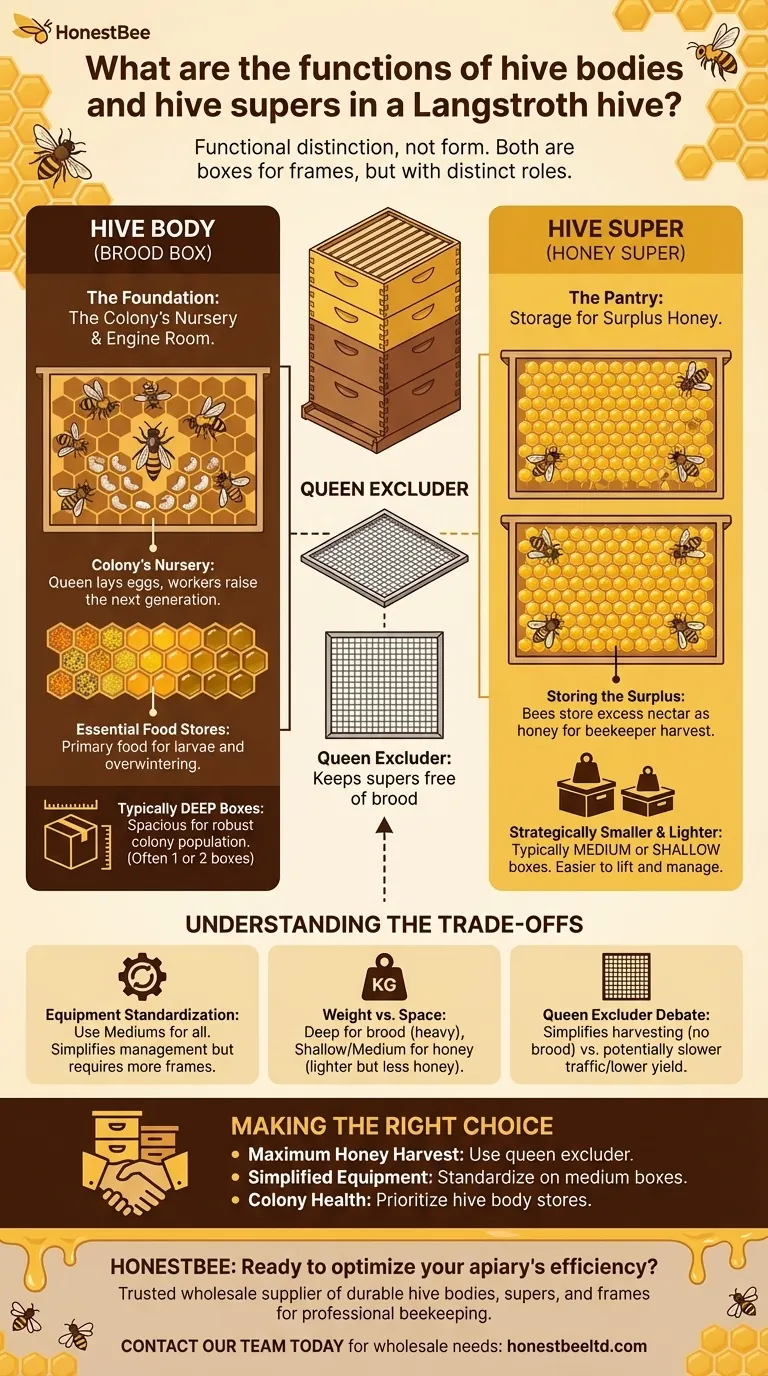In a Langstroth hive, the distinction between a hive body and a hive super is one of function, not form. Both are rectangular boxes that hold frames. However, the hive body is the core of the colony, housing the queen, brood (eggs and larvae), and the bees' essential food stores. The hive super is an additional box placed on top, specifically intended for the storage of surplus honey that a beekeeper can harvest.
The modular design of a Langstroth hive strategically separates the queen's brood chamber (the hive body) from surplus honey storage (the hive super). This allows beekeepers to manage the colony and harvest honey with minimal disruption to the hive's essential nursery.

The Foundation: The Hive Body (Brood Box)
The hive body, often called the brood box or deep, forms the bottom and most critical section of the hive. It is the permanent home and engine room of the colony.
The Colony's Nursery
This is where the queen lays her eggs and where worker bees raise the next generation of bees. All hive activity is centered around supporting the health and growth of the brood nest contained within these boxes.
Essential Food Stores
In addition to brood, the frames in the hive body also contain stores of pollen and honey. This is the colony's primary food source, crucial for feeding larvae and surviving the winter.
Typically Deep Boxes
Hive bodies are most commonly "deep" boxes. This larger size provides the queen with a spacious, unbroken area to lay eggs, which promotes a healthy and robust colony population. A hive may consist of one or two deep brood boxes.
The Pantry: The Hive Super (Honey Super)
Hive supers, or honey supers, are the boxes stacked on top of the hive body. Their sole purpose is to provide space for the bees to store honey that is beyond the immediate needs of the colony.
Storing the Surplus
When nectar flow is strong, bees will gather more than they can consume. They store this excess as honey in the supers, effectively creating a pantry. This is the honey a beekeeper harvests.
Strategically Smaller and Lighter
Supers are often "medium" or "shallow" boxes. A box full of honey is extremely heavy, and using these smaller sizes makes them much easier for the beekeeper to lift, inspect, and harvest.
The Role of the Queen Excluder
To ensure the supers are used only for honey, many beekeepers place a queen excluder between the top hive body and the first super. This is a screen with openings large enough for worker bees to pass through but too small for the larger queen, preventing her from laying eggs in the honey supers.
Understanding the Trade-offs
The Langstroth system's flexibility presents choices, and each comes with practical considerations for the beekeeper.
Equipment Standardization
Some beekeepers choose to use medium-sized boxes for both the brood nest and the honey supers. This simplifies management, as all boxes and frames are interchangeable. The trade-off is that it requires more boxes to equal the brood space of a deep, creating more frames to inspect.
Weight vs. Space
While deep boxes are ideal for the brood nest, they can weigh over 80 pounds when full of honey. This makes them impractical as honey supers for many people. The choice of super size is a direct trade-off between management effort and the amount of honey stored per box.
The Queen Excluder Debate
Using a queen excluder keeps the honey supers free of brood, which simplifies harvesting. However, some beekeepers believe the excluder can slightly slow down worker bee traffic into the supers, potentially reducing the overall honey yield.
Making the Right Choice for Your Goal
Your management strategy for hive bodies and supers depends entirely on your primary objective.
- If your primary focus is maximum honey harvest: Use a queen excluder to ensure your supers contain only pure, easily extractable honey.
- If your primary focus is simplified equipment: Standardize on a single box size (typically mediums) for both brood chambers and honey supers.
- If your primary focus is colony health: Always ensure your hive bodies are heavy with food stores before adding supers, prioritizing the bees' needs over your own harvest.
Ultimately, understanding this division of labor between the hive body and the super is the foundation of effective and sustainable beekeeping.
Summary Table:
| Component | Primary Function | Common Size | Key Takeaway |
|---|---|---|---|
| Hive Body (Brood Box) | Colony's nursery & essential food storage. Houses the queen and brood. | Deep | The permanent, foundational home of the hive. |
| Hive Super (Honey Super) | Storage of surplus honey for beekeeper harvest. | Medium/Shallow | The removable 'pantry' for excess honey production. |
Ready to optimize your apiary's efficiency and honey yield?
As a trusted wholesale supplier to commercial apiaries and beekeeping equipment distributors, HONESTBEE provides the durable, precisely crafted hive bodies, supers, and frames you need to implement these best practices at scale. Our equipment is designed for the rigors of professional beekeeping, helping you manage colonies more effectively and maximize productivity.
Contact our team today to discuss your wholesale needs and discover how our supplies can support your operation's success.
Visual Guide

Related Products
- Langstroth Bee Hives Bee Keeping Box for Beginners Beekeeping
- Australian Pine Wood Langstroth Screen Bottom Board for Wholesale
- Professional Galvanized Hive Strap with Secure Locking Buckle for Beekeeping
- Automatic Honey Flow Beehive 4 Frame Mini Hive for Beekeeping
- Professional Drop-Style Hive Handles for Beekeeping
People Also Ask
- What are the different types of beehive boxes available? Choose the Right Hive for Your Apiary
- Why might a beginner be advised to start with a Langstroth hive? Unlock a Supportive Beekeeping Ecosystem
- What basic equipment is needed to start beekeeping? Your Essential Guide to a Confident Start
- How does the orientation of the hive sides benefit comb construction? Ensure Straight, Movable Combs for Easier Hive Management
- How does the ease of access differ between 8-frame and 10-frame hives? Choose the Right Hive for Your Body



















